Demonic
(Australia 28 minutes)
Dir. Pia Borg
screens with:
The Giverny Document
(US France 42 minutes)
Dir. Ja’Tovia Gary
In the International short and medium length competition at RIDM, Demonic and The Giverny Document are non-linear, impressionistic films that evoke trauma via collages of direct and archival footage. Demonic kicks in with a shot of an escalator ascending toward a sun-filled skylight. Ironically, a distressed woman in voiceover murmurs about an ominous dream as a male voice leads her deeper into her sunken place.
The woman is Michelle Smith, who during the 1980s “remembered” cult horrors from her childhood. The man is British Columbia psychiatrist Dr. Lawrence Pazder, who encouraged Smith to dredge up supposed memories of Satanists fond of locking up children in snake-filled cages, raping them, and eating babies. Pazder wrote Michelle Remembers, a book about his patient’s experiences. The best-seller helped trigger crazed accusations hurled at daycare workers and pre-school teachers, some of whom were charged and imprisoned for years.
Pazder is a recurring presence in Demonic, which deploys precise images suggesting his empty, meticulously furnished office, an audio tape recorder playing on a table. Director Borg builds an eerie sense of Michelle Smith’s suffering. The camera pans coolly around the office and pulls back down a corridor, as if we were in Kubrick and King’s Overlook Hotel.
As it progresses, the doc merges the film’s staged shots with TV news footage about the Satanic panic in California’s McMartin Pre-School. Scenes of people digging up foundations in search of secret tunnels leading to altar rooms where children were sacrificed, therapists waving around idiotic hand puppets inducing kids to “remember” suppressed memories, and clips from daytime talk shows that fanned the flames are all dredged up again. Geraldo was big on the Satanic threat, and shots of Oprah on a TV in an empty room convey how the media was complicit in perpetuating delusions and destroying lives.
In The Giverny Document, artist-filmmaker Ja’Tovia Gary articulates the vulnerability of Black women while celebrating their beauty and power. Like Demonic, the film swings back and forth between staged material and found footage, with swirls of Norman McLaren -esque animated colour keeping the energy flowing. In some moments, the animation and live action play off each in split screen combinations.
Gary goes further: images burst from the screen in synch with electronic rhythms. Retro black and white shots of a Haitian dancer and drummer shock cut to gunsights on military planes, bombs exploding far below. With colonialism on our minds, a travelogue narrator says the “carnival traditions” of France continue. Really? Did Caribbean carnival originate in France?
At the heart of the doc, Gary positions herself on a busy Harlem corner (Malcolm X Boulevard and 116th Street) to ask Black women and girls if they feel safe in their bodies and in the world. The street interview footage is rough-hewn in contrast with the jump cut and pixilated apparitions of Gary in the lush verdant beauty of Claude Monet’s Giverny Garden. Here the street interviewer, barefoot in a floral dress and at one point striding voluptuously naked, becomes what she calls a “négresse imperiale.”
Power juxtaposes with vulnerability, highlighted by recurring shots through policemen’s gunsights and the sound of cops ordering women to drop to their knees. Some interviewees in Harlem say they feel safe because they “walk with God,” or they know themselves well. Young girls tell Gary they are okay when they’re not threatened by violence, or followed by lechers.
Encapsulating all of it, Gary repeatedly cuts to giant closeups of Nina Simone’s heartbreaking performance of “Feelings” at the 1976 Montreux Jazz Festival. Who could be stronger and tougher than Miss Simone? Who could be more at the mercy of the world?
While Borg’s film Demonic opens onto an inescapable delusionary world, Gary’s The Giverny Document depicts the ongoing reality of pain and the transcendence of it.











